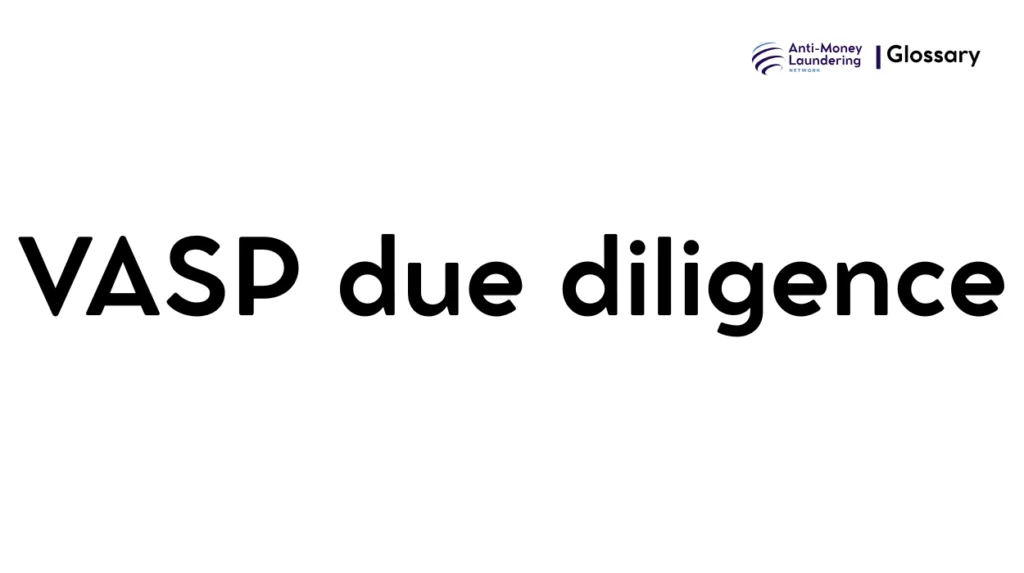Understanding Virtual Asset Service Providers (VASPs) and their due diligence obligations is crucial for compliance officers and financial institutions navigating the rapidly evolving digital asset landscape. This guide covers comprehensive aspects of VASP due diligence in AML compliance.
Definition
VASP Due Diligence refers to the comprehensive process by which Virtual Asset Service Providers evaluate, verify, and monitor their customers, counterparties, and business relationships to prevent money laundering, terrorist financing, and other illicit financial activities within the virtual asset ecosystem. It involves measures such as Customer Due Diligence (CDD), ongoing transaction monitoring, and risk assessment, tailored to the unique risks posed by virtual assets and VASP operations.
Purpose and Regulatory Basis
Role in AML
VASP due diligence helps detect and mitigate risks associated with the misuse of virtual assets for illicit finance, protecting the integrity of financial systems and meeting legal requirements.
Why It Matters
Virtual assets, due to their digital, cross-border nature, can be exploited by criminals for laundering proceeds or financing terrorism. Effective due diligence ensures VASPs do not become unwitting facilitators of such activities.
Key Regulations
- Financial Action Task Force (FATF) Recommendations: FATF Recommendation 15 mandates AML/CFT obligations for VASPs, including the “Travel Rule” for transaction information sharing.
- USA PATRIOT Act: Extends AML obligations to virtual asset businesses under the definition of money transmitters.
- EU AML Directives (AMLD 5 and AMLD 6): Define and regulate VASPs, requiring customer verification and reporting.
These frameworks insist on risk-based approaches, licensing, customer identification, record-keeping, and transaction monitoring accordingly.
When and How it Applies
Real-World Use Cases
- Opening accounts or wallets with a VASP.
- Conducting virtual asset exchanges or transfers.
- Engaging in custodial services for virtual assets.
- Performing transactions above regulatory thresholds.
Triggers for Due Diligence
- Onboarding new customers or counterparties.
- Enhanced scrutiny for high-risk jurisdictions or activities.
- Suspicious transaction detection.
Examples
A crypto exchange conducting identity verification before allowing a user to trade, or performing enhanced due diligence if the user sends funds to a sanctioned country.
Types or Variants
- Standard Customer Due Diligence (CDD): Basic identification and verification as per regulation.
- Enhanced Due Diligence (EDD): Applied to higher-risk customers or transactions, involving deeper scrutiny.
- Simplified Due Diligence (SDD): Allowed in low-risk scenarios.
- Counterparty VASP Due Diligence: Assessment of other VASPs involved in transactions to ensure regulatory compliance and risk mitigation.
Procedures and Implementation
- Establish institutional risk assessments to identify vulnerabilities.
- Implement systems for customer identification and verification (e.g., KYC processes).
- Maintain comprehensive record-keeping of transactions and due diligence documentation.
- Monitor ongoing transactions for unusual or suspicious activity.
- Screen customers against sanctions lists promptly, ideally within 24 hours.
- Train staff on AML/CFT risks and compliance obligations.
- Use technology solutions for transaction monitoring and risk analytics.
Impact on Customers/Clients
- Customers have the right to transparent due diligence procedures.
- They may face restrictions or delays if verification requirements are not met.
- Personal data is collected and protected under privacy laws but used for AML purposes.
- Enhanced scrutiny may affect privacy but aims to protect both client and provider from illicit risks.
Duration, Review, and Resolution
- Due diligence is continuous: initial checks at onboarding and ongoing monitoring.
- Periodic reviews based on risk profiles.
- Updating customer information when significant changes occur.
- Resolution of issues by escalating suspicious activity reports (SARs) to authorities if necessary.
Reporting and Compliance Duties
- VASPs must document CDD processes and make records accessible to regulatory authorities.
- File SARs promptly when suspicious or unusual activities are detected.
- Cooperate with audits and regulatory examinations.
- Failure to comply can result in fines, license revocation, or legal sanctions.
Related AML Terms
- Customer Due Diligence (CDD)
- Enhanced Due Diligence (EDD)
- Suspicious Activity Reporting (SAR)
- Know Your Customer (KYC)
- Travel Rule
- Sanctions Screening
- Risk-Based Approach (RBA)
Challenges and Best Practices
Challenges
- Difficulty verifying true identities due to privacy-enhancing technologies.
- Complex cross-border transactions complicating jurisdictional compliance.
- Emerging technologies and decentralized platforms hindering supervision.
Best Practices
- Implement robust, technology-assisted identity verification.
- Maintain updated institutional risk assessments.
- Collaborate internationally to share information and harmonize standards.
- Provide continuous staff training.
Recent Developments
- Enhanced FATF guidance emphasizing Travel Rule implementation.
- Increasing regulatory focus on DeFi platforms and non-custodial wallets.
- Advancements in AI-based transaction monitoring systems.
- Growing emphasis on transparency and licensing of VASPs internationally.
VASP due diligence is a cornerstone of AML compliance in the virtual asset industry, ensuring that digital asset service providers can effectively prevent, detect, and report illicit financial activities. Compliance with due diligence procedures protects institutions, customers, and the overall financial system from abuse while aligning with international regulatory standards.

